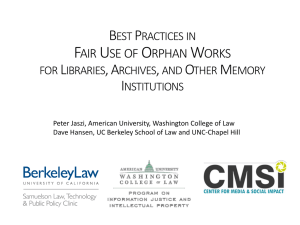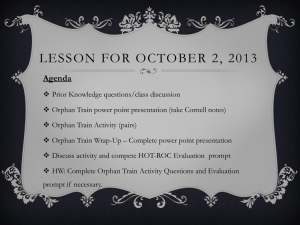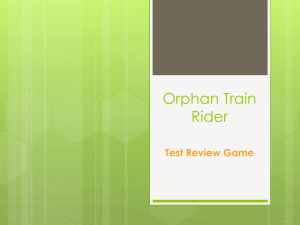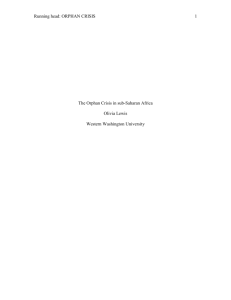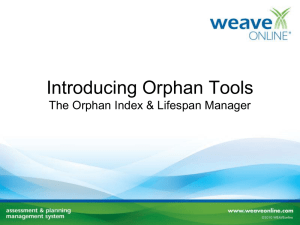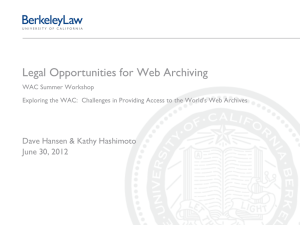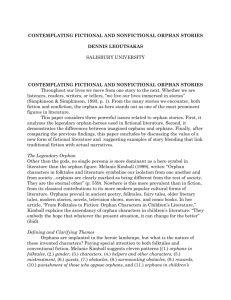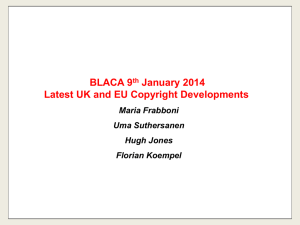Orphan Works
advertisement
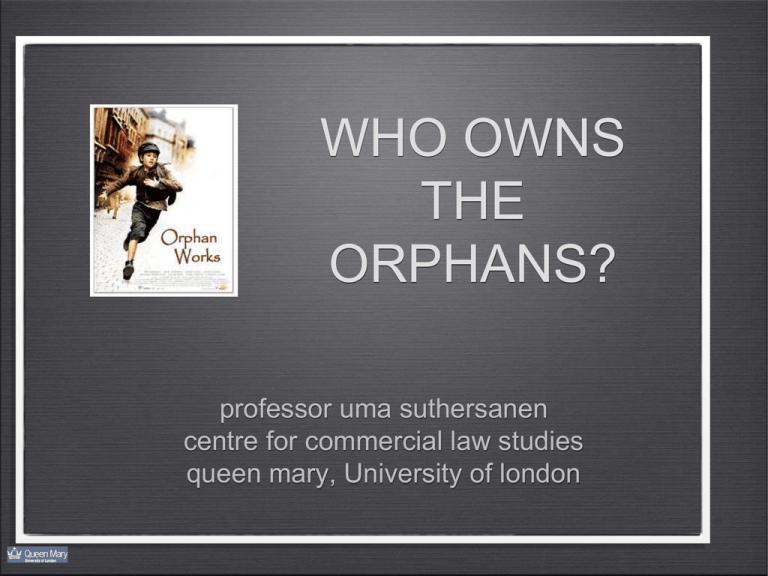
WHO OWNS THE ORPHANS? professor uma suthersanen centre for commercial law studies queen mary, University of london “If we do not reform our European copyright rules on orphan works and libraries swiftly, digitisation and the development of attractive content offers will not take place in Europe, but on the other side of the Atlantic.” Viviane Reding, Commissioner for Information Society and Media ‘Clarification and transparency in the copyright status of a work is an essential element in a number of areas including the European Digital Library Initiative. In some cases rightholders cannot be identified or located; as a result, works can be classified as “orphan”. Comprehensive, large-scale digitisation and online accessibility, as well as other uses, are hampered by this phenomenon. As a result, libraries, museums, archives and other non-profit institutions may be prevented from fully exploiting the benefits of information technology to carry out their preservation and dissemination mandate.’ Report on Digital Preservation, Orphan Works, and Out-of-Print Works: Selected Implementation Issues: Origins of Orphans Inadequate identifying information about ownership, co-authorship or physical location Inadequate information about copyright ownership due to a change of ownership or to a change in the circumstances of the owner, Copyright owner does not realise that they benefit from copyright ownership Copyright owner has died and inadequate information on new ownership Difficulties researching copyright information, especially grey material Where the copyright owner is a business, the business ceased to exist and it is impossible to find out what happened to the copyright which was one of the business assets The work was never meant to be commercially exploited in the first place Length of duration of copyright in published and unpublished works European Commission: Legislative Initiative Legislative initiative on "orphan" works for digital libraries Expected date of adoption of the initiative (month/year): November 2010 European Commission: Legislative Initiative Europeana - a pan-European digital library and archive, in order to make Europe's cultural heritage available online Majority of Member States have not yet developed a regulatory approach with respect to orphan works Initiative seeks to, by means of binding legislation, introduce an obligation on Member States to identify orphan works published in their territories and to establish mechanisms for their online display. The entire system would then allow seamless EU UK Report In from the Cold: An assessment of the scope of ‘Orphan Works’ and its impact on the delivery of services to the public Report prepared by JISC for the Strategic Content Alliance Collections Trust - a collaboration funded by public sector organizations comprising of JISC, British Library , BBC, Becta, Museums, Libraries and Archives Council UK Report: Extent of Problem Estimates vary as there is no agreed definition of ‘orphan works’ dependent on the sector and nature of work UK’s public sector - measured at 5% to 10% on average Archives and libraries sector - reaching up to 50% BBC estimate - 1m hours of broadcast footage classified as ‘orphans’ British Library estimate - 40% of all works are ‘orphans’ Total number in UK survey - excess of 13 million orphans Individual estimates within single organisations - hold in excess of 7.5 million orphans Total sample of 503 organisations could represent - in excess of 50 million orphans UK Report: Types of Orphans Works with little commercial value, but high academic and cultural significance User generated content, works by amateur or local artists and works by artists using aliases Documentary Photographs Sound recordings Letters, diaries and unpublished text based works Amateur‐made films UK Report:Orphan impact assessment Rich primary resources being ‘warehoused’ at public expense Estimates of approximately 5 million works being locked from access No delivery of works online to the public without additional costs and/or risks being imposed on the public purse. British Library Sound Archive - total of 150 freelance and 152 staff hours (302 hours) resulted in eight permissions being received 6.5 million days to clear all orphan works for works in survey (approx. 18 000 years). UK Report: Recommendations I What did surveyed participants want? Checklist to demonstrate due diligence (50-60%) Establishment of a national copyright database; setting up of a central agency to administer rights; common transparent system for recording and granting permissions in real-time and at low cost Licensing scheme (20- 30%) Larger organisations more likely to buy into a licensing scheme Comments as to the complex licensing schemes already available were restrictive Schemes that cover Orphan Works would help those for whom the issue is time-consuming or risky, inhibiting development of commercial strands, or organisations and projects for whom it is impractical to carry out due diligence searches or which are large enough for an extra fee to be incidental. UK Report: Recommendations II Legislative change: copyright exceptions (60-70%) Legislative change providing legal certainty (50-60%) Total amnesty on the use of Orphan Works Remove Orphan Works from the copyright act Copyright exception - distinction between works of high commercial value and of those of low commercial but high academic value Copyright exception - extend ‘educational purposes’ to cover organisations across the public sector involved in educational activities, and to cover public access to materials (as public education) Include details of permitted use if every effort has been made to trace the creators and this can be proved UK Report: Final “The scale and impact of Orphan Works across the public sector confirms that the presence of Orphan Works is in essence locking up culture and other public sector content and preventing organisations from serving the public interest. ... Without any kind of UK or European Union-wide legal certainty, there will remain a major risk for all users of Orphan Works....... Whether the answer is a UK or an international one, involving a change in practice and interpretation and/or a change in legislation, this is clearly a matter of urgency. Without these legal safeguards, the contribution of public sector content to a global digital landscape will continue to be severely curtailed and the levels of public resources to manage copyright will be unacceptable.” European Union: Orphan Impact Assessment Assessment of the Orphan Works Issue and Costs for Rights European Commission DG Information Society and Media Unit E4 Access to Information May 2010 EU:Extent of ProblemI Conservative estimate as a percentage of European in- copyright books - 3 million orphans (13 % of the total number of in-copyright books) Older books - higher percentage European film archives - 129 000 film works are official orphans; 225 000 film works are unofficial orphans 95 % of British newspapers from before 1912 are orphans. 90% of British photographs in museums (approx. 17 million photographs) are orphans 95% of images in the UK National Archives between 1883 and1912 were untraceable (researchers are given these images subject to notice that researchers themselves responsible for obtaining permission from the right holders) EU:Extent of Problem II Danish National Library - 160 000 works from the period 1880-1930 with uncertain orphan status. US - For 1872-1957 it is estimated that only 2% of all works protected by copyright are commercially available US - in 1930, over 10.000 books were published in the USA, but in 2001 all but 174 were out of print Source: The Economic Structure of Intellectual property Law, Posner R. and Landes W. 2003 EU:Extent of Problem III Bodleian Library - 4,756,746 books were published in the UK from 1900 - present Assumption: total of UK orphan books = the total of UK books published in 1950 or earlier which are still in copyright and whose authors are dead Assumption: authors of works are alive when the work is published, and that they will die at a rate of 2% a year over the subsequent 50 year period Estimate rate of orphans in UK : increase gradually and be around 627 688 books in the UK alone in 2009. This is about 13% of the total (roughly 4,756,746) of UK books in copyright. Estimate no. of orphans in 27 EU Member States: 4 million. Assumption: Publishing rate of Germany, Spain, France and Italy = UK; Publishing rate of Austria, Ireland, The Netherlands, Poland, Portugal and Denmark, Finland and Sweden put together = 1/5 UK; Publishing rate of rest of the Member States = 1/10 UK. To avoid any over-estimation the number may be reduced to 3 million books. Bearing in mind that all EU countries have the same term of copyright, the proportion of orphans could be assumed to be the same for Europe-27, i.e. 13 % in lack of better evidence. Source: Society of College, National and University Libraries, SCONUL, January 2010 EU:Extent of Problem IV In-copyright books between 1900 and 1939 : 95 % of rightsholders untraceable In-copyright books between 1940 and 1988: 75 % were untraceable In-copyright authors - 100% of the contacted right holders granted permission to use the work, without remuneration EU: Origin of Orphans 2 types of orphan works Works whose right holders are unidentified or unclear Presumed that the work is protected, as no death date can be established Holder of copyright remains unclear in situations where the original right holder (author) is identified but there is uncertainty about the current right holder of the work Likely that ‘old’ publishing contracts have never covered the digital use of the work Provisions about the term of protection for older works make the establishing of copyright protection exceptionally difficult - for example the revisionary copyright provisions of the 1911 Copyright Act have caused "orphans" UK law contains also a specific provision giving unpublished materials copyright until 2039 Works whose right holders cannot be traced or located Information about their whereabouts is not available or has become outdated. Possibly multiple legal heirs. When the rights have been assigned to a company, the company might have gone out of business, or gone bankrupt without clear assignment of assets. EU:Impact assessment: Transaction Costs I High transaction costs Rights clearance not part of the normal activities of publicly funded institutions (except public service broadcasting companies Costs for published materials reduced if rights holder information is available within registries of collecting societies and publishers or databases kept by libraries. Few collecting societies grant licences for cultural institutional use - only on the music or visual sectors Some RROs developing rights clearance services for distance education etc. and library uses. Registries of collecting societies do not usually include right holder information for grey literature - i.e. materials published by non-professional publishers (corporate or governmental publications) or unpublished materials (amateur photographs, music or video content created by non-professionals). EU:Impact assessment: Transaction Costs II National Library of the Netherlands - a title by title search is not feasible for large scale digitisation projects which normally include thousands of right holders to possibly hundreds of thousands works. Library states that although it has concluded collective agreements with right holders, the use of potential orphan works by the library remains infringing, because this collective solution lacks a legal basis. Library advocates that the EU should introduce a Europe-wide, mandatory legal solution for both orphan works and mass-scale digitisation, which does not require a diligent search on a per-work basis. EU:Impact assessment: Transaction Costs III Austria: 200 000 digitised German dissertations from 1925 – 1988 in the collections of a university library cannot be made accessible online because transaction cost would be 20-50 times higher than cost of digitisation UK: Wellcome Trust project digitising posters from the 1980's spent £ 70 000 in transaction costs for clearing the rights for just 1 400 posters European Union: Solutions Denmark: strengthened their extended collective licences to cover orphan works Hungary: A centrally-granted, nonexclusive licence solution EU: ARROW project (in conjunction with European Digital Libraries project) is working on developing databases on right holders of books. European Union: i2010 Report Final Report on Digital Preservation, Orphan Works, and Out-of-Print Works i2010: Digital Libraries High Level Expert Group – Copyright Subgroup European Union: i2010 Core principles: Report Diligent search criteria that a user needs to fulfil prior to the use of the work Databases of orphan works to facilitate users in their search, which is needed irrespective of any legislative solution A rights clearance procedure and Rights Clearance Centre to grant licences European Commission: Legislative Initiative The 6 Options Option 1 Do nothing Option 2 Statutory Exception Clarify legal status of orphan works Exception allowing online display of orphans in EU Compensation if owner appear Options 3, 4 and 5 3 Versions of Copyright Licences Extended collective digital licensing Specific licence for digital display of orphan works Centrally granted State licence for digital display of orphan works Option 6 System of Mutual Recognition AHRC Project: Who owns the orphans? Traditional and Digital Property in Visual Art Who owns the orphans? the research team Grant Holder and Principal Investigator - Professor Uma Suthersanen, Queen Mary, University of London AHRC Fellow - Dr. Maria Mercedes Frabboni, Queen Mary, University of London Consultant - Dr. Daphne Zografos, IQsensato, Geneva
